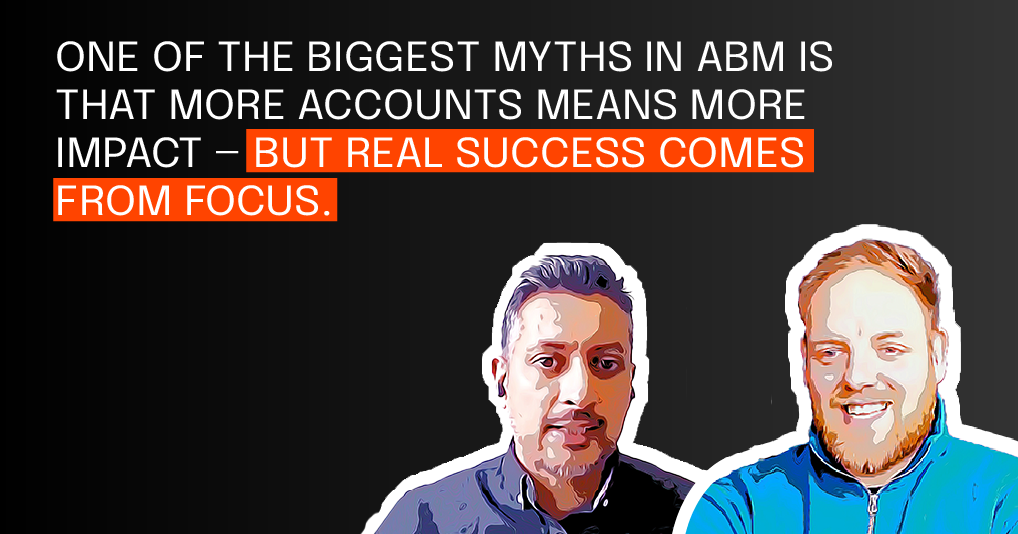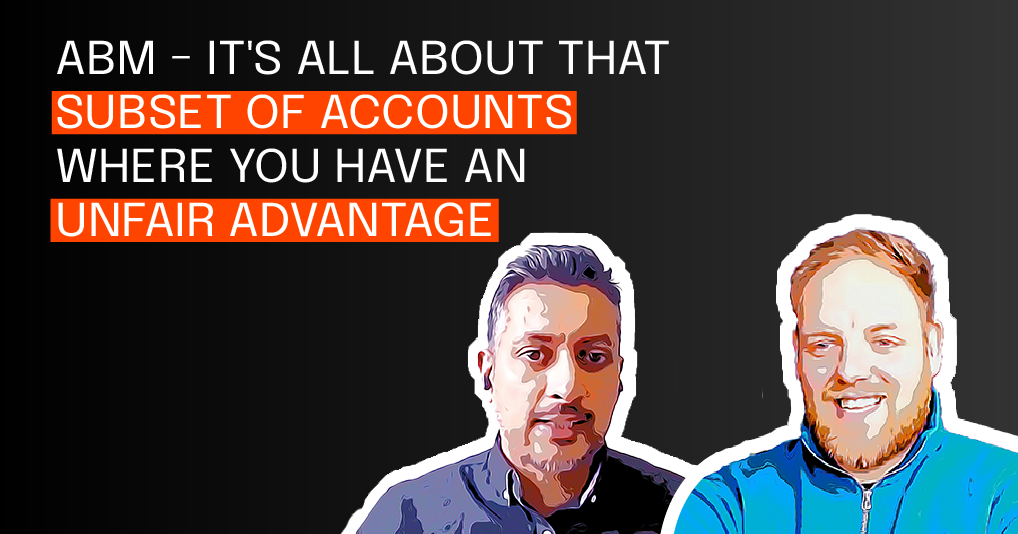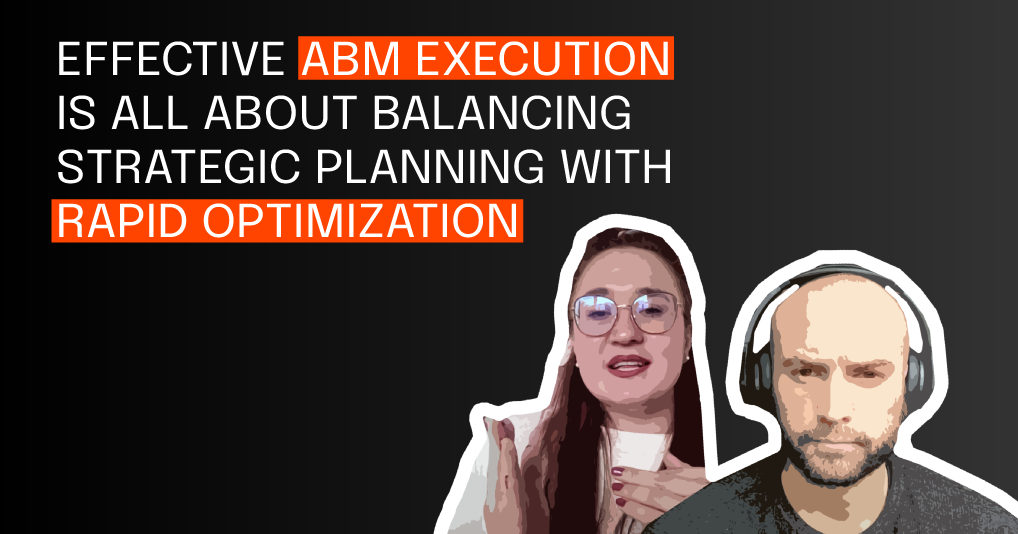Top 10 ABM Challenges
6 July 2023
Jack Rawlings & Josh Weale ▪︎ Heads of ABM
In ABM, challenge is everywhere. In this episode, Jack and Josh explore the top 10 challenges faced when setting up an ABM program.


Josh is a Head of ABM, leading the development of innovative strategies to help enterprise tech businesses win, grow and retain their most important accounts. With a background in journalism and several years of client-side experience, he works with Sales and Marketing teams to help them succeed.
ABM Lunch and Learn
Fast forward your team's ABM learning and accelerate your growth
We’re on a mission to create great ABMers
Subscribe to our ABM insights and podcast releases.
With ABM there's a challenge at every turn - especially when first getting started. In ABM Under the Hood Episode Two, we look at the top 10 challenges teams face when launching or running an Account-based strategy.
We know that an Account-based Marketing program has many moving parts. Getting it to run like a finely tuned engine takes hard work and knowhow!
So as strategicabm's Heads of ABM; this week, Jack Rawlings and Josh Weale share their insight into the main issues and difficulties Marketers face with an Account-based set up.
They explore everything from understanding how to pivot to, or get started with ABM, to knowing what ABM tech you need – and don’t, to securing buy-in and defining success metrics and more. Go Under the Hood to see how to get started.
Read Podcast Transcript
Jack Rawlings (strategicabm) – Welcome to another episode of ABM Under the Hood. My name is Jack Rawlings, and I'm joined today by my colleague, Josh Weale. Hi, Josh.
Josh Weale (strategicabm) – Hey, Jack. Good to be here.
Jack (strategicabm) – So, today's episode, we're talking about specifically the top 10 ABM challenges that businesses face when setting up an ABM program, in particular. And this is based around an article and a video that our colleagues, Declan and Fes Askari, have done, which is available on the strategicabm website, and in the ABM Under the Hood section of that website, the resources section there.
So today, we're going to talk about the top 10 ABM challenges in a little bit of detail, but also in the context that, in future episodes, we're going to really dig into, sort of, further depth on each of them. So, there'll be specific episodes kind of focused around those challenges.
We're not necessarily going to do it in the order that we go through today, or that's in the article because, you know, people start at different points in their, kind of, journey, and are at different stages. So, we're not going to necessarily kind of run through it in a chronological order as such, but more so just as we, kind of, want to talk about specific issues and challenges that we see, we'll kind of base our episodes on that.
ABM Challenge #10: Which accounts should we target?
So, the first challenge that we'll talk about today, and in a future episode in a bit more depth, is the challenge number 10 in the article, which is: Which accounts should we target? And that I think is something that, I certainly have that conversation on quite a regular basis, probably, you know, more often than not with teams who are first, you know, starting ABM for a first time, looking to potentially, kind of, roll out a wider program. You know, maybe a One-to-many program, something like that. It's the question of, kind of, prioritization, and certainly prioritization of resources internally, as well, is something that crops up a lot.
How do you kind of, how do you think people should approach that, businesses should approach that? Is it something that we, you know, is it something that is very standardized for every business? Or is it something that's kind of contextual depending on where they're at? What's your sort of, what do you think on that side of things?

Josh (strategicabm) – Yeah, I think from my perspective, and what I see quite often is, it is very dependent on the context of the business. Because we have some businesses that we work with who have a very clearly defined target market. They know exactly what their product does, who it serves and who it's best to serve.
And in those instances, it's a bit more straightforward, because you know that you're going into a market, and you're targeting a specific vertical, and you know exactly what the value is that can be offered into that vertical. So, for those businesses, it's a little bit more straightforward. There's still kind of caveats and nuances to it, but for those businesses, it's more straightforward.
But when you are, kind of, thinking about an ABM program that's going into, I guess, some of that, kind of, white space – where you are still trying to really figure it out – that's when it does become a little bit more complicated.
But really, when you're thinking about account selection in the context of an ABM program, from my perspective, it's about aligning to the objectives: What is it that you actually want to achieve with your ABM program? Do you want to win more enterprise-sized businesses? If that's a target. Do you want to build, kind of, your footprint within some of your existing accounts?
Because there's obviously different remits that you can go after. So, it's ultimately about understanding what it is that you're trying to achieve as a broader business objective, and then actually looking at where it makes the most sense to focus your resources.
So, going through that, kind of, process of building your Ideal Customer Profile, doing account selection to prioritize and segment your target accounts, and starting to get a really good understanding of what is the value that you're actually going to communicate? And who are you going to, kind of, build a campaign around?
The only other thing that I would add to that, as well, is once you, kind of, do that, obviously Marketing have their preconceptions of who they should go after, who they're best fit for. Sales, they have their own preconceptions as well. So, the most important thing really is that, regardless of what you in Marketing think, what you in Sales think, it's really important that the two teams align and have the same, kind of, thinking around, kind of, who it makes the most sense to go after.
Because, it's a challenge because if you get pulled in too many different directions, then you can very quickly end up, kind of, spread too thin, and your ABM program lacks the resources to actually deliver value to anybody. So, I would say that as well.
Jack (strategicabm) – Yeah, I mean, I get a question sometimes, which is, sort of, along the lines of: Well, can we not target – it's not necessarily can we not target everybody – it's can we target a bigger list? Can we target more people, more accounts?
And I sort of, you know, the response to some extent is: "Yeah, sure, you're welcome to, we can... But, it's going to require a lot more resource, a lot more budget, a lot more time. You know, essentially, a lot more prioritization." So, the answer is yes, you absolutely can, but if you mean, can you do it within the same sort of parameters as, you know, what's been discussed, then, you know, probably not, no.
There's a reason why we, sort of, set things at that sort of level. And, you know, when we talk about a One-to-many program, you're probably talking at sort of 100 to maybe, you know, a couple of hundred accounts maximum, of, you know – I never try and go above 1,000. I think 1,000 is really kind of pushing it into more, sort of, Demand Gen territory, there.
And then yeah, One-to-few, you know, it's a handful of accounts. It's 10, 15, however many you kind of, you've got the budget and time internally to, sort of, focus on. But yeah, it's certainly something that's difficult.
But, you know, we'll in the next episode or the episode that we, kind of, focus on, you know, account selection and that side of things, we'll definitely dig into, you know, the 'how': The sort of process that we follow. The sort of, yeah, the, kind of, the roadmap that we set out for clients to kind of get into picking specific accounts, and understanding that market as well.
Josh (strategicabm) – Yeah.
Jack (strategicabm) – So. Sorry, go on.
Josh (strategicabm) – I was just going to say, the other thing that I think is important, as well, is having some form of data to actually support the decision of who you target.
Jack (strategicabm) – Yeah, exactly, yeah.
Josh (strategicabm) – Because as I said, like, you can have an idea of where your product is best suited, and who it fits with, but if you've got data to actually validate that and actually drive the decision-making process, then it's a lot more, kind of, robust and you're not, kind of, basing everything on assumptions.
Jack (strategicabm) – Yeah, yeah, exactly. Yeah, 100%, totally agree. Cool.
ABM Challenge #9: Pivoting to ABM
So, the second challenge that we're going to talk about now, and we'll go into more detail on at a later date in another episode, is how to move to an ABM program. Like, how to pivot to ABM, essentially, from another go-to-market strategy, another, sort of, way of Marketing, essentially.
So, particularly I think you hear teams that have done, you know, maybe Demand Gen or Lead Gen or something like that, and aren't, you know, 100% sure of what it takes to, kind of, make that move over.
But I think, probably the main thing that I would suggest is that it's not a small thing to do, and I think that's probably, it's something that clients we work with and businesses don't necessarily always appreciate the scale and the magnitude of doing this.
I'm not saying that it's, you know, it depends on where you've come from, right? If you're coming from a Demand Gen background, then you're looking to, kind of, start a One-to-many program, it's not a huge transition, right? And if your business is sort of brought in on that. But if you're starting at, you know, zero Marketing, or a little bit of Lead Gen or Influencer Marketing, or something like that, and you're looking to roll out a huge, you know, blended ABM program – One-to-many, One-to-few – that's going to take some doing. It's going to take some time, as well, to actually do that.
And so, that patience that's needed for that, sort of, setup of an ABM program, I think is absolutely fundamental. Shall I, yeah, anything else to add on that one?
Josh (strategicabm) – Yeah, I think when you're thinking about how do you pivot to an ABM strategy, as you said, it really depends on where you're coming from. But the kind of advice that I often give to clients when I'm working with them is that you should think of ABM as part of a broader Marketing mix.
Because quite often, if you think that you have to – and it goes back to that silver bullet thing. If you think that ABM is going to completely transform everything you do, then it could get quite painful, because if you put all of your eggs in that single basket and then you actually find that you don't have the resource, or something changes in the market and you have to react to that, then it becomes a bit more difficult to actually...
Jack (strategicabm) – No, I think, no, I think, no, but I think you're bang on. 'Cause like, basically, it is defining that balance between what's a big, you know, it is a big change, even if it's not necessarily, we are not suggesting that it should be the thing that you put everything onto.
We're not saying... in fact, that's the point we're making: We're not saying you should move all of your business and all of your Marketing efforts across to an ABM program overnight. That's not going to be effective, or successful, or even possible, really.
What we're saying is there should be a slow, patient transition towards an ABM way of thinking, at the same time as, you know, making sure that the other tactics, other channels, other strategies are still in place, and, you know, supporting that. ABM is not something that operates in silo. It's something that works as part of that wider mix. So, I think that's, yeah, I think that's the point that we're trying to make.
Josh (strategicabm) – And this is why we quite often recommend that people who want to go into ABM should start with a pilot program. Define a very small kind of pilot, define which accounts it is that you want to target, and start to run some tests, and experiment.
Really understand what is it that's valuable to them. Understand your audience: Do the insights work? And just get some signals back from the market and understand how are they resonating with that messaging. And if you start to see, kind of, this is really making a difference and starting to make an impact, then scale from there. But, don't just go from, kind of, what you're doing today to ABM tomorrow without really considering, kind of, the implications for your wider Marketing.
Jack (strategicabm) – Yeah, absolutely. Yeah, totally agree.
ABM Challenge #8: Changing internal perceptions
How do we change the perception of ABM internally in the business? I think it, sort of, links to what we were just talking about, really, in regards to this sort of more patient, slow transition. You know, not trying to rush things and put everything into one, you know, put all the eggs in the ABM basket straight away, essentially.
So, I don't think there's a huge amount that, you know, that you can do necessarily beyond the way that you do, you know, you set out the ABM program, right? I think trying to extol the benefits and virtues of the ABM program before you've set one up, to a business who isn't necessarily bought in, isn't really the way of going about it.
You almost want to, as you say, you start with a pilot program, you start with something small to start demonstrating the results, to then be able to take that, kind of, business case back, right, and have that conversation. I think people respond better to, you know, what's in front of them, what they can see, rather than what they're, sort of, you know, what people are saying.
So, I think that would be the main sort of advice I would go with there. But we'll talk about that a little bit more on a future episode as well, I think.
Josh (strategicabm) – Yeah. I think that the only thing that I would add is just making it understandable. Use the same language that your business uses already.
Jack (strategicabm) – Yeah, that's a good point, yeah.
Josh (strategicabm) – If you start to come at it with, kind of, Marketing jargon and a load of acronyms that nobody really understands what they mean, then it's only going to serve to make things more difficult when you're asking those questions about – or you are being asked the questions about – where the value is.
Jack (strategicabm) – Yeah, that is a really good point, and it's one that I'm massively guilty of, to be honest of you. I find myself talking in so many three letter acronyms on a day-to-day basis, and I kind of forget that, you know, we're not, not everyone, yeah, not everyone likes to, kind of, communicate in that way, if you're not in Marketing particularly, so.
ABM Challenge #7: Resourcing an ABM program
The next challenge is about how to resource ABM. How would you go about resourcing an ABM program? And this is one of those that's kind of a bit like: How long is a piece of string, right? Because it really depends so much on different factors: you know, what type of ABM program, who you're targeting, what technology stack you've got, you know, the level of maturity within the business when it comes to understanding ABM.
Like, there's so many factors there that will, you know, impact what level of resource or how you go about getting the necessary resource that you need. Anything else that you think people need to be aware of with that?
Josh (strategicabm) – Yeah, I think from my perspective, what I would say is that, when you're thinking about setting up your ABM program, you should consider, kind of, the resource that you have available, and do the things that are highest impact first.
Jack (strategicabm) – I guess what you're saying is, essentially, that there's ways to kind of get into an ABM program and an ABM way of thinking, without necessarily having to embark on a full-scale program from the get go. Particularly if you're short on resources internally. Or, you know, and you've got, you need to find a way to, kind of, prioritize that resource.
So, there are things that you can do that move the needle, without necessarily having to, without necessarily having to, you know, commit to a full ABM program from day one. Is that sort of what you meant?
Josh (strategicabm) – Yeah, it was, yeah. And I also think it's about, kind of – again, this is kind of cliché – but testing and learning. And making, kind of, small bets quickly to find out what is it that works, what is it that doesn't work. And starting to understand and build a picture of how your target accounts behave, what they like to see in the market, what they don't like to see. And just really understanding, kind of, if we can figure out what is working, how do we scale that as quickly as possible into a more, kind of, sophisticated program?
I mean, for me, that's kind of a real key challenge, is that often we see, kind of, ABM programs where it's just, throw as much as possible at the wall and see what sticks.
Jack (strategicabm) – Yeah, yeah.
Josh (strategicabm) – But we completely don't advocate for, kind of, just throwing a load of money at a problem. It's about, kind of, starting small, understanding what works, and then scaling from there.
Jack (strategicabm) – Exactly, yeah, 100%. Cool.
ABM Challenge #6: Driving more opportunities
So, the next challenge is: How to drive more opportunities. And I'm guessing what people kind of mean by that is how to drive more opportunities from an ABM program, specifically. I think this is one that's going to need a lot more discussion in a future episode. I don't think this is something we can answer in a couple of minutes. 'Cause there's so many different things that we need to, kind of, touch on there.
But what I would say is, you know, the same thing that we, kind of – and you'll hear this phrase probably 100 times more over the next, you know, few episodes – is Sales and Marketing alignment.
You know, that for me is probably, when it comes to opportunities, when it comes to that, kind of, the revenue sort of metrics of those three Rs that we're measuring, I think it's got to be about that Sales and Marketing alignment. Not just in terms of the picking and choosing of the accounts, which we mentioned before, but actually the engagement and the activation of those accounts. You know, having the Sales team working in a way that is aligned with what the Marketing team have done previously is, I think, absolutely essential.
Josh (strategicabm) – Yeah, and I think it comes down to, again, kind of, where you've come from. If you've come from, kind of, a Lead Generation background, like as a Marketer working in that kind of function, you're used to, kind of, hitting MQL quotas, and SQL quotas, and trying to, kind of, generate leads that are passed onto Sales. And then, that kind of has the benefit to a Marketer of, kind of, you get so far and then it's job done. Whereas, there's still some work to do on the Sales side of things.
But the reality is that, within an ABM program, you have to take those numbers on your own shoulders as well, as a Marketer, and work in partnership with the Sales team, and together have a joint number that you're working towards. So, it's not just this, kind of, handoff piece around, kind of, "Oh, we've seen some interest, now go and, kind of, engage them."
It's about, kind of, taking ownership for a number that's driven around revenue; understanding what the leading indicators are towards that number; and, kind of, how can you support your colleagues in Sales to, kind of, really capitalize on any engagement that you see from a reputation and relationship point of view?

Jack (strategicabm) – Yeah, and the other point with that, as well, is that two-way feedback loop, right? So, if you haven't got that alignment with Sales, you're not getting that information back from them about what's worked, what people are talking about in the Sales process, you know, all of that kind of stuff, which you'd need.
'Cause you want to be able to bring that back into the Marketing. You want to be able to talk about, you know, what the Sales team is seeing succeed in their activities, as well. So yeah, that's super important. But there's a lot more to that in terms of driving opportunities that I think we'll cover in upcoming episodes, for sure.
ABM Challenge #5: Building the right Tech stack
Another one that, again, is probably a good episode or even maybe two episodes worth of discussion is around tech stack, technology – what can we use for that? And I think the way we'll probably approach this for upcoming episodes is talk about the, kind of, minimum viable tech stack that you need.
And, you know, there's some debates around that, but we can obviously have a bit of a discussion there about, you know, what's absolutely fundamental to an ABM program? 'Cause there are things that are, you know, absolutely fundamental. And then what things are, you know – then we'll probably have a separate conversation around what, you know, maybe a, sort of, next-level-up ABM tech stack looks like. You know, if you're, kind of, scaling up the program and you've got a bit of budget to spend, what can you, kind of, invest in?
And then potentially, we'll kind of look at something along the lines of a gold-standard ABM tech stack. If you had, you know, all the budget, all the time and resource to set things up, what would you, kind of, invest in? And maybe approach it in that way.
But, you know, from a tech perspective, I think the, kind of, key things that we'll be touching on is, you know, obviously intent data, CRMs, Marketing automation, you know, potentially some Sales automation stuff as well. So yeah, that's, kind of, the main things.
Obviously, you know, activation tools, ad platforms and email platforms – all of that kind of stuff as well will come into it. But I think that's, yeah, I think that's a much, much bigger conversation for a future episode.
ABM Challenge #4: Getting started with ABM
The next challenge is around how to get started with ABM. This one I think, you know, this really does, kind of, harp back to what we were talking about with that first one when it comes to pivoting to ABM. I think it's a similar thing.
Potentially, it's more focused around how to develop – what does that first few, you know, month, couple of months look like in practice in an ABM program? Versus, kind of, what does the lead-up into it look like? I think it's more about, yeah, what's that first month, couple of months of an ABM program look like in practice? So, we can talk about that certainly in a next episode.
ABM Challenge #3: Budgeting for ABM
Challenge number three in the article, and another challenge is, essentially, budget. What's the right budget for an ABM program? Have you got any thoughts on that? It's a bit of a loaded question, probably, that one!
Josh (strategicabm) – Yeah. I mean, again, it comes back to, kind of, understanding: What are you trying to achieve? What's the size of your organization? What are the sizes of your, kind of, deals that you're trying to win?
Because ultimately, it comes down to, kind of, where's the return on your Marketing investment? So, understanding, kind of, what are you putting in to get out. So, if you've got, kind of, really high-value deal opportunities that are, kind of, transformative for your business, then it's worth making that investment to the right point.
But it's about, kind of, being smart with that investment and understanding, kind of, well, where are the channels that I can see the most, kind of, return? And obviously, you can get into conversations around, kind of, return on ad spend and that kind of thing. But, in terms of what general budget do you need?
I think ultimately, you have to ask the question of, what are your objectives? If it's existing customer strategy, then you've already, kind of, got a lot of information and intel you can use to start building your pilot. If it's a new acquisition, then there's the level of research and insight that you need to gather, and that can take a little bit more time and a little bit more budget to do that.
But yeah, ultimately, it really depends on who you're trying to win, what you're trying to achieve, what kind of size of deals that you're going after. And building a view of, kind of, what that looks like over the next, kind of, 12, 18 months, two years – depending on, kind of, your Sales cycle.
Jack (strategicabm) – Yeah, and I think it's, yeah, you mentioned the objectives side of things there. I think that's absolutely pivotal, and I think it's something that we're going to go into a lot more in detail in a future episode because, yeah, ABM objective setting is so key to so many aspects of what we are looking at here.
It's not just important to, you know, the budget, but it's important to your reporting, your KPIs. It's important to the way that your program's being perceived by the business. All of this kind of stuff that we've, kind of, discussed. So, I think it's going to be an important one to cover as a separate episode, that.
On the point of reporting and ROI, the next challenge is how to measure the success of an ABM program. This is, for me, yeah, I mean, I would probably put this as challenge number one, actually, in my list, 'cause this is something that is not, it's not an easy thing to do, right? There's so many different tools available. There's so many different data sources. There's so many different ways of thinking about the data, and the metrics, and the campaigns.
And so, you know, there are certainly some standardized ways of measuring things that we will talk about. But, there's also a lot of nuance within that as well, right? There's so many things that we need to be, you know, thinking about when it comes to specific client use cases, all of that kind of stuff.
ABM Challenge #2: Measuring success & ROI
Josh (strategicabm) – Yeah, so when it comes to, kind of, thinking about how do you measure your ABM program, I think it's also important to understand, kind of, well, who's the audience for your reporting? Because on a day-to-day level, what you need to understand is, kind of, from a tactical point of view: How much engagement do we have? Who are we reaching? What are they doing?
All of that is, kind of, vital information to understand how your program is making an impact. But ultimately, that's quite in the weeds. And when you're trying to report and measure the success of your ABM program, you're talking at a much higher level. And you want to understand, kind of, what is the overall impact for the business, and understanding, how does it relate back to the value to the business and being able to align that.
So, we can obviously go into a lot more detail around this in later episodes. But I think one, kind of, key point to make is it's about understanding where you are today, taking that, kind of, view as like a benchmark or a temperature check, and just being able to use the three Rs – to measure reputation, relationships and revenue. And providing, kind of, an executive level, kind of, dashboard or scorecard that really shows the impact that you're having over the course of the program. 
Jack (strategicabm) – Yeah, absolutely. Yeah, and I think that we're going to go into the three Rs a lot throughout this series, 'cause it's certainly probably the easiest way to be thinking about this stuff. But then there's a lot more, kind of, within that that we'll need to dig into as well.
ABM Challenge #1: Sales & Marketing alignment
The final challenge is around how to align Sales and Marketing, which is something we've mentioned numerous times already, just in this episode alone. But yeah, it's going to be a question we return to all the time.
That 'how to' is the interesting point, 'cause I think we talk about the importance of it. We've definitely mentioned that. But how to actually do it, how do you get that Sales buy-in, first of all, but also, yeah, you know, working together as a team. How do you go about that? That's something that I think we've, there's lots of different things that we can talk about there. So, that's definitely one for a future episode in entirety, I think. Is there anything that you wanted to mention on that now?
Josh (strategicabm) – Yeah, I mean it's obviously a big topic. There's a lot of different ways, there's a lot of different approaches. We see, kind of, all sorts of different shapes and sizes when it comes to Sales and Marketing alignment.
But I think, ultimately, the key to it all from my viewpoint, is it's about speaking the same language. And if you can speak the same language and understand everything that each team is doing, and feel like you're one team, then that's, kind of, how you can best, kind of, foster a collaborative approach.
Jack (strategicabm) – Yeah, I think you're right. The silo thing of – it's almost, you know, there's an argument to suggest calling it an ABM team, right, that actually includes the Sales and Marketing teams within it. I think I've seen that work in some businesses. It depends on the size of the business and where they've come from and blah, blah blah. But the fact that it's called Sales and Marketing, it just innately creates this division and this silo, right? And that's something that you've got to try and avoid in an ABM program.
But, well anyway, that is a rundown, sort of top-level summary of the top ABM challenges that businesses are facing today. And something that we are hearing, you know, things that we are hearing on a regular basis, as well.
In upcoming episodes, as I mentioned, we'll be talking about some of those in a lot more detail, specifically, kind of, giving actionable tips and strategies and insights from our work on a, sort of, day-to-day basis with businesses that we work with, as well. Examples, sort of, from the field to, kind of, give you some ideas how to maybe approach and solve some of those issues that we've mentioned. So, looking forward to talking more about that in upcoming episodes.
Make sure your ABM engine is finely tuned. Subscribe to future episodes.
Let's talk
Looking to start your ABM journey or need help with your current program? We'd love to know more.
Here's a simple form to start the conversation
Alternatively - grab a time here to talk
- Follow strategicabm on X
- Follow strategicabm on LinkedIn
- Follow strategicabm on Facebook
- Follow strategicabm on YouTube
- Follow strategicabm on Instagram
© 2026 strategicabm / Strategic ABM Ltd. All Rights Reserved | Privacy
Strategic ABM Ltd is a private limited company registered in England & Wales. Registration number 13082021.
HubSpot Platinum Partner
Google Certified Partner
Nexus Gold Accredited Partner







